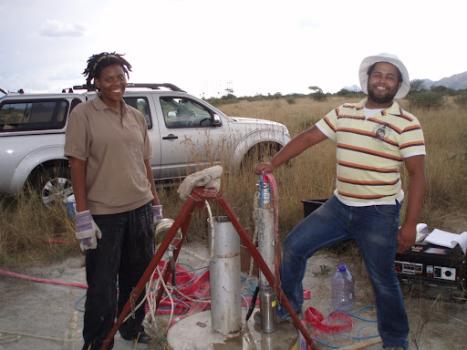Invisible yet Incredible: Groundwater
Groundwater is the theme for this year’s World Water Day. Did I read that right? Yes, there it is, 2022’s official theme: Groundwater, Making the Invisible Visible. Only once before have we seen World Water Day focus on groundwater, but that was decades ago, long before Twitter, iPhones, Facebook, and even Gmail. Why are we suddenly trying to make it visible now, in 2022? Has groundwater decided to finally show itself? Has it turned 18 and become an adult? Come to think of it, what is “groundwater” anyway? Let’s dig into this a little more…
Corner a groundwater specialist, and they will bore you witless with tales of how groundwater gets shunned, ignored, misrepresented, and misunderstood. We hydrogeologists can be sensitive about this stuff. Groundwater is water that is found in the gaps, cracks, and spaces in the rocks beneath us. And here’s the thing: around 98% of the world’s liquid freshwater is groundwater. Around half of all the water used to irrigate our food crops is groundwater. Most rural people in low-income countries rely entirely on groundwater (check out this video from a recent research project for more on that). In fact, there are many countries — from Denmark to Bangladesh — that use groundwater almost exclusively for all their water supplies.
When it comes to water, all you seem to hear about are rivers, lakes, river basins, wetlands, and reservoirs. That’s because, as humans, we like to use our eyes. If we cannot see something, we tend to ignore, or at least downplay it. Just try looking at the carbon dioxide in our atmosphere. Well, you cannot because it is invisible. You can bet that if carbon dioxide and methane made the air turn bright purple, we may have sorted out emissions years ago.
In order to “see” groundwater, we have to use gizmos or gadgets like water level meters, pressure gauges, and flow meters. We also use resistivity arrays and gravity sensors on some occasions. It may sound boring and overly technical, but it does explain why hydrogeologists get excited about groundwater data and groundwater maps. That is our way of seeing groundwater and the aquifers (the rocks through which groundwater slowly moves) it’s found in.
Getting to the groundwater can be a messy process. Anyone who has been to a well-drilling site has witnessed a mess of mud, noise, and diesel machinery, as the well is being drilled. Surely, no one drinks water coming from there?
But some people are trying to turn the tide, so to speak, and working to improve the public knowledge and understanding of what is actually a truly remarkable natural resource. After all, groundwater is normally found close to where it’s needed, and its natural quality is often so good that it can be drunk without any treatment at all. It is the world’s most extracted raw material, and when used wisely it is renewable. That is why, for all its mystery, groundwater is a focus of USAID’s Bureau for Humanitarian Assistance (BHA) and other donors and organizations working to improve living conditions worldwide.
In particular, groundwater is absolutely essential for maintaining food systems. Food production requires large quantities of water, often through irrigated agriculture. In many countries, groundwater is the solution for this source of irrigation for a number of reasons, in addition to its universal access and reliability as a water source:
- Groundwater irrigation is key for increasing food production, and it improves resilience to weather-related shocks. Irrigation can also increase the diversity of foods produced (like fruits and vegetables and more nutritious foods during the dry seasons), which helps with food security and nutrition.
- Groundwater irrigation has been associated with poverty alleviation, and it can improve livelihood opportunities. Extracting groundwater is also important as a safe and accessible source of drinking water, which in turns can improve health and nutrition outcomes.
Like groundwater itself, a lot of the information and data on groundwater can be invisible too. That’s why we at PRO-WASH got into the spirit of 2022’s World Water Day theme by compiling a handy guide to free and downloadable resources, called A Guide to Online and Accessible Resources on Groundwater. Check it out and find more information on groundwater resources, especially groundwater in Sub-Saharan Africa. We have divided it up into categories, including groundwater resources for teachers and children, and places to go for mentoring, support, and resources for younger hydrogeologists. As an example of what you’ll find, check out the amazing Groundwater Project. They are a team of specialists working to post a ton of groundwater information, books, videos, and guides to the Internet, all free of charge. There is even a book for kids, called “Wally and Deanna’s Groundwater Adventure… to the Saturated Zone.” It’s available in ten languages so far, including Hausa and Hungarian!
As you can tell from this blog, we here at PRO-WASH are really delighted about UN-Water’s 2022 World Water Day theme “Groundwater, Making the Invisible Visible.” Celebrate with us by exploring some of all the resources linked in this blog! Here’s one more and it’s a great one: UN Water’s groundwater overview.
This article was originally posted on FSN’s Medium page. Lisez ce blog en français ici.


